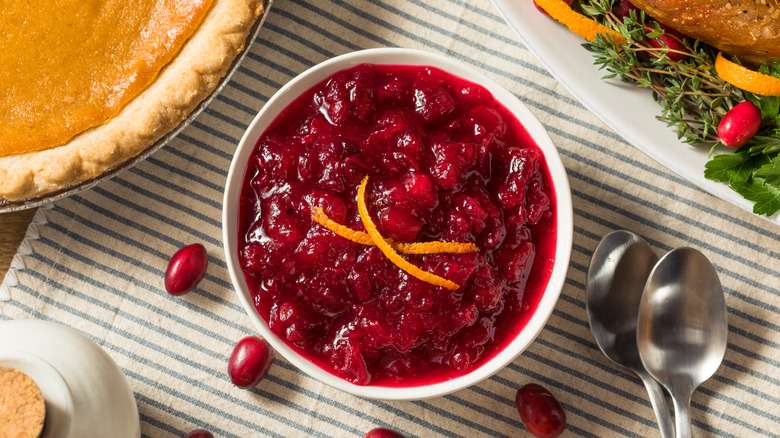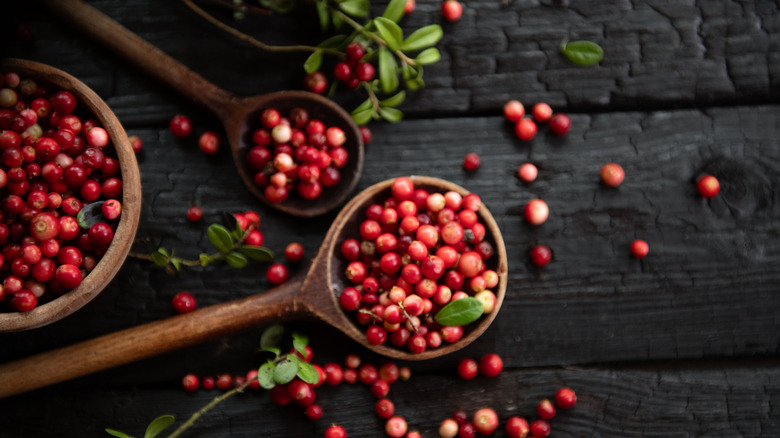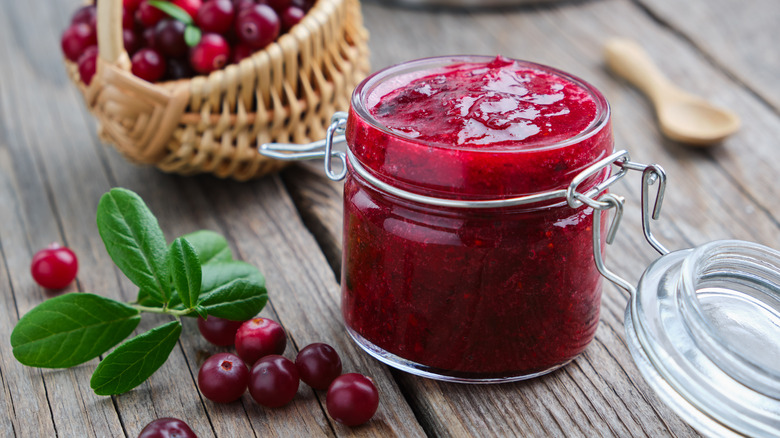Should You Add Pectin To Home-Canned Cranberry Sauce?
Autumn is the peak cranberry season. It's the time when these tart, bright red berries are ripe and ready for harvesting, and you can find bags of fresh and fresh-frozen cranberries at your local supermarket. This fruit also plays a supporting role during one of the season's biggest holidays — Thanksgiving. Cranberry sauce can be found on the dining tables at countless Thanksgiving gatherings in the United States. Some people think it's not a proper turkey dinner without it.
At its simplest, cranberry sauce is made of cranberries that have been cooked down with sugar and water. Some recipes recommend adding orange juice or orange peel to give the sauce bright, sunny citrus notes. If you want to savor the flavor of cranberry sauce all year long, you can make a batch from fresh or frozen cranberries, and freeze it for later use. Cranberries are a remarkable fruit known for its tart flavor that also contains high levels of pectin, something to consider if you choose to preserve cranberries by canning them.
Cranberries are naturally pectin rich
Pectin is a plant fiber that can act as a thickener in cooking, and it also has gelling properties which are necessary for preserves to set properly. It's important to know how much pectin a fruit has if you're going to make a preserve from it. If a fruit's natural pectin levels are too low, it won't come together as a jam or sauce without some assistance. That's why you can buy pectin in powder form to use in canning low-pectin fruits. Fruits with naturally low levels of pectin include cherries, peaches, pears, and strawberries.
Fortunately for cranberry sauce fans, these berries are quite high in pectin. This means the level of pectin naturally present in the little red berries is high enough and has enough acid to gel properly when the fruit is cooked with just sugar. Other fruits with high pectin levels include plums, quinces, and lemons. The ripeness of the fruit will have an impact on its pectin content, however. Overripe fruit has less pectin, and underripe fruit has more pectin. One way to determine if your cranberries are ripe is their color; ripe cranberries are a bright crimson red. A lesser-known test for ripeness is whether or not the cranberries bounce.
Citrus peel can increase pectin
Your cranberry sauce can get an extra boost of pectin if you decide to add in some orange peel. Orange peel, as well as the skins from other citrus fruits, are quite high in natural pectin. But the actual fruit in the citrus fruits isn't — just the peels are. So if you cook the cranberries together with orange or lemon peels, the sauce is likely to come together and gel even better than using cranberries alone.
You want to take care when cooking your cranberry sauce, though. You don't want to overcook it and end up with a sauce that's too thick. If this happens, you can always loosen it up with a splash of water or juice. Some recipes suggest adding a tablespoon of orange liqueur, too.
You may also want to experiment with seasoning your cranberry sauce. A dash of salt can counterbalance the sugar in the dish. Cinnamon sticks and cloves can give the sauce an autumnal twist. Just remember to remove the whole spices after you finish cooking the sauce. Whatever twists you give to your preserved cranberry sauce, or if you choose to keep it as basic as possible, the natural pectin in the berries is all the pectin you need.


